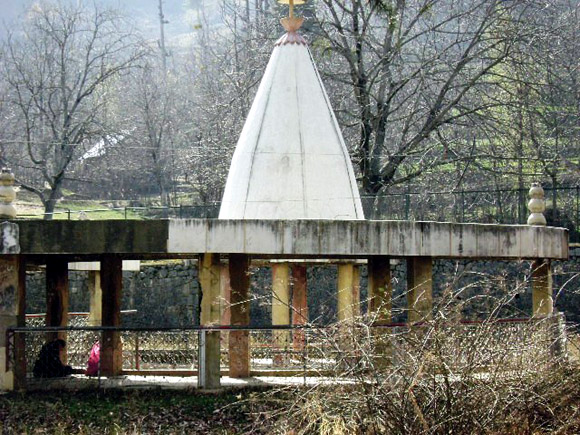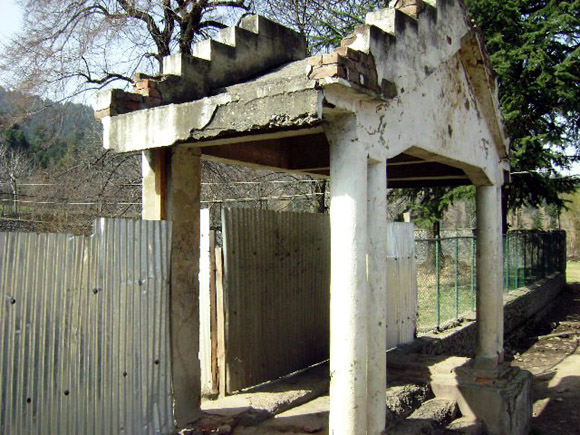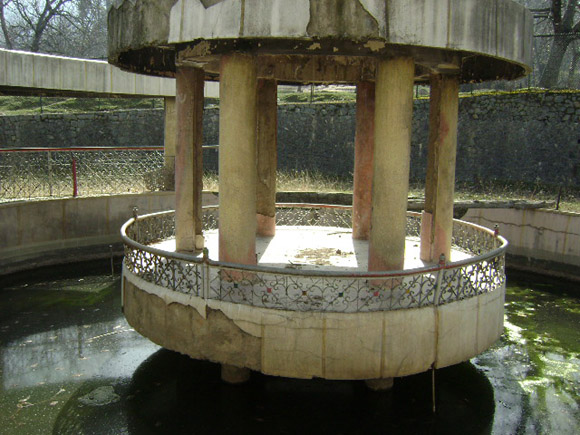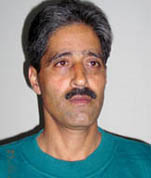|
|
|
Forgotten Temples of Kashmir
Photo series Part-8 An effort to preserve and record Hindu cultural and religious heritage of Kashmir Brari Aangan…..The Abode of Goddess Uma  (Close veiw of the shrine. Now there are only wild shrubs around it formerly a path of salvation) Exclusive images and report from a remote village in Kashmir provided for Shehjar by Chander M. Bhat |
|
Haji Karimdad Khan, who is mentioned in history as one of the harshest and most tyrannical Afghan Subehdars of Kashmir, deputed in 1772 A.D. a junior executive, Shri Ram Kaul Jalali, to collect land revenue and other taxes from the Kuthar pargana in the Anantnag tehsil. Shiv Ram had already been initiated by a ranking preceptor in spiritual discipline and on reaching Brari Aangan in Uttersoo he intensified his meditative practice. In the course of a few months he attracted the attention of the people around who frequently came to see him to seek initiation at his hands. Soon he resigned his job and devoted himself to meditation on Goddess Uma in the form of ‘Aumn’. Shri Mather Kaul of Uttersoo used to take milk as a food to Sh. Shiv Ram Jalali. These facts were reported to the subehdar who summoned Shiv Ram to Srinagar. The latter did not go but put his heart and soul in meditation under a shady tree. The subehdar was annoyed and sent some troopers to ‘bring Shiv Ram to his senses’ and to drag him to the capital. On reaching Shiv Ram’s place of meditation they were dismayed to find him guarded by two leopards, one to his right and the other to his left. The mounted soldiers wanted to swoop upon Shiv Ram in the manner they were directed by the subehdar who considered Shiv Ram’s recalcitrance to grave offence, but had their mounts shied and backed, ran helter-skelter, and sustained injuries along with the riders. Crest-fallen, the soldiers reported the whole matter to the subehdar at Srinagar. Haji Karimdad Khan was the hero of many battles in Afghanistan and India, including Kashmir. He went to Brari Aangan to check personally all that was reported to him. Catching a glimpse of Shiv Ram from a distance he found him flanked by two cats, but when he approached closer he was astounded to find two leopards instead. Nothing daunted, he spurred his mount to charge, but it fled in the reverse direction. The truth dawned on the Haji and Shiv Ram was no longer an average mortal but had attained stature under the protection of Divinity. He gave up his arrogance and approached the saint in all humility. The leopards instantly changed into docile cats. Shiv Ram who was all along in his meditation gradually returned to normalcy. The subehdar expressed his appreciation of Shiv Ram by granting him land for a shrine and 1600 kanals of rent-free agricultural land for its upkeep and for a free kitchen for visiting pilgrims. Soon thereafter many people, Hindus and Muslims, settled on the land around. It came to be known as Uma Nagri but the common man called it as Brari Angan, the courtyard of cats, on account of the role of the feline species in the evolution of the village. Shiv Ram was also called as Shivananda. He used to lit Dhooni (sacrificial fire) every morning and the place of Dhooni was called Dhooni Sahib. After the nirvana of Sh. Shiv Ram (Shivananda) the local saints from Pandit family and Koul family took the reigns of Uma Nagri Shrine. The last saint of the shrine was Swani Satyananda who was a teacher by profession and belonged to the local Koul family. He was a bramchari and attained nirvana after the mass exodus of pandits from the valley. Two bandaras (yagna’s) are celebrated every year, one on the occasion of birthday of Goddess Uma during navratras and another on nirvana divas of Sh. Shiv Ram in the month of January-February. The two celebrations are now offered at Jammu by the ancestors of Koul family of whom Swami Satyananda belonged. One of the saints namely Swami Soimaanda of Ganpatyar, Srinagar who was blessed by the Goddess had also contributed a lot for the construction of the shrine at Uma Nagri and then at Jammu after the exodus. The yegna is also offered at Uma Devi Temple, Muthi, a replica of Uma Devi Shrine of Brari Aangan. Hawans are also offered at Sharadapeth, Bantlab, Jammu every year by the followers of Swami Satyananda.1 A tom-cat is referred to as bror (pl. ‘brare’) in Kashmiri and its female counterpart is braer (pl. brari). Braer is derived from Sanskrit word Bhataraka meaning ‘worshipful’ as in Bhattaraka Nadvala which is the present Brarinambal according to Stein. The name Brari Angan is therefore fully appropriate for the village. The 1600 kanals donated by Haji Karimdad Khan continued to be utilized for the shrine from April 13 (Basakhi), 1781 A.D. for nearly a century and half. It was reduced to 964 kanals in the reign of Maharaja Pratap Singh who sanctioned a grant in cash for the Dharmarth Trust for the area resumed. In the period around 1950s the estate was reduced to just 182 kanals under the agrarian reforms of the state. A separate forest area was also offered by the Dogra rulers to the shrine. Haji Karimdad Khan’s land grant thus provides a historical explanation for the ‘why’ and ‘how’ of the name Brari Aagan. The common noun braer is occasionally invested with divinity as the expression Braer Maji (Mother Goddess) or in such lila songs as Raji Reni rani Braeri Laga yai paeri paeri (All praise to her who, known as Rani (queen) Braer, is the consort of the Almighty. It adds a new dimension to the place name which bridges historical facts with diving grace, reminding one of Goethe’s adulation:
Wouldst thou the earth and heaven
In order sole name combine
Tehrik Kashmir mentions another spot on the crest of the Zojila pass
which also was known as Brari Angan. It states that from time to time
many people felt carried away by the sound of music and minstrelsy, they
imagined, they heard there. Their companions applied the rough and
ready therapy of flogging to bring such an individual back to normalcy
so that he did not lag behind the caravan and get frozen to death.2
There were seventy KP families residing in this village prior to mass exodus which includes Kauls, Bhats, Ganjoos, Pandits, Khars, Bhans and Marhattas. At present there is no KP family in this village. The Uma Shrine in Brari Aangan is now in ruins. The icon of the goddess was destroyed and the same is resting at the bottom of the main spring. The surrounding of the shrine was raised to the ground in a fire during 1990. Two dharamshalas surrounding the shrine were capable to sustain about a thousand of devotees. The moorat and soorat (aakar and sorup) of Goddess Uma is still inscribed in heart of every devotee. There were three springs of diameter 12 mts/8 mts and 11 mts. The springs were having crystal clear water and were located like a triangle in the shape of Omkara. The shrine is spread over an area of 600 feet area. On the west side of side of the shrine, there is a samadhi of Shivananda in a long rectangular plot which was fenced with wooden blocks. On the eve of Nirvana Divas of Shivananda and on birth anniversary of Goddess Uma a banner/Jindi of red colour was used to be hoisted in front of the Uma Shrine. Shivananda used to perform Ashtnag Yoga on a clay pot which was existent till late seventies. The holy Jatta (hair lock) and wooden Kharoaw were shifted to Jammu Shrine by Swami Satyananda. The same are displayed for darshan on the day of Yagna at Sharda Peeth, Bantlab, Jammu. The devotees of Uma are very eager to see the Uma Shrine at Utrassoo back to its glory, but the big question is ‘who will take the initiative’? References: 1. Uma Jivani, Svamyananand Ashram, Srinagar 1975 2. Place Names in Kashmir by B.K.Raina and S.L.Sadhu published by Bharatiya Vidya Bhavan, Mumbai and Indira Gandhi National Centre for the Arts, New Delhi 3. Interview dated 15.03.2010 with Sh. Pushker Nath Koul son of Sh. Niranjan Nath Koul resident of Uttersoo presently residing at Sector 2, Durga Nagar, Jammu |
 Main entrance to the shrine. Pathetic cruelty of the time. |
 Main Temple. Outrageous Mata left without any address. |
 a Holy Spring. Sacred waters still purifying the sins of devotees |
 One of the three springs in the lawns of the shrine. Resembling to netra of Lord Shiva |
 Once this was a Snan Ghat outside the temple. Unity of the commands of nature |
 aTwin Springs like neglected sisters |
 Lawns of the Temple. These lwans were full of devotees before 1990 |
 Hawan Kund near the main entrance without any roof now. Reminances of glorious past |
 Remains of Dharamshala outside the shrine. Human behaviour is un-predectable |
 Nature on its duty |
 Neglected Spring inside the lawns of the Shrine |
|
|
 *Born
on 20th March, 1960 in Murran a village in North Kashmir, Chander M.
Bhat is presently working as an Assistant Supdt. Posts, in Department of
Posts, Govt. of India. His articles regarding Posts and of
non-political nature stand widely published in various papers and
magazines of the country. A booklet 'How to Collect Stamps" published by
the Department of Posts, has earned him genuine accolades. He worked on
the project of tracing the roots of his co-villagers and of the village
Murran, resulting into the culmination of a widely acclaimed book
"Murran -My Village". Man with depth, Chander M. Bhat has also another
book, "Ocean by Drops" (collection of poems) in his vase having colorful
poems. His book "Ancient History of Jammu and Kashmir", confirms his
researching capability. Various research papers like "The Splendor that
is Amarnath" and "Vitasta" The Sacred River of Kashmir" are valuable
additions to his works that has proved very fruitful and guiding force
in the exile period of Kashmiri Pandits community of which the author is
also a member. *Born
on 20th March, 1960 in Murran a village in North Kashmir, Chander M.
Bhat is presently working as an Assistant Supdt. Posts, in Department of
Posts, Govt. of India. His articles regarding Posts and of
non-political nature stand widely published in various papers and
magazines of the country. A booklet 'How to Collect Stamps" published by
the Department of Posts, has earned him genuine accolades. He worked on
the project of tracing the roots of his co-villagers and of the village
Murran, resulting into the culmination of a widely acclaimed book
"Murran -My Village". Man with depth, Chander M. Bhat has also another
book, "Ocean by Drops" (collection of poems) in his vase having colorful
poems. His book "Ancient History of Jammu and Kashmir", confirms his
researching capability. Various research papers like "The Splendor that
is Amarnath" and "Vitasta" The Sacred River of Kashmir" are valuable
additions to his works that has proved very fruitful and guiding force
in the exile period of Kashmiri Pandits community of which the author is
also a member.Presently the author is working on "OOL - THE NEST" a six volume project on all the 595 (each volume of about 2500 pages)Kashmiri Pandit villages of Kashmir. |
|
|
Monday, October 1, 2018
An effort to preserve and record Hindu cultural and religious heritage of Kashmir Brari Aangan…..The Abode of Goddess Uma
Subscribe to:
Post Comments (Atom)

No comments:
Post a Comment